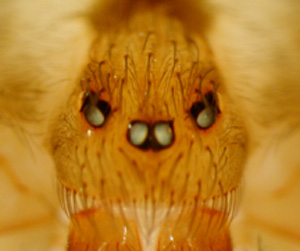Quick and Dirty Guide to
Identifying a Brown Recluse
 Although this is an accurate picture of an adult recluse, there is some
color and pattern variation, and juveniles are even harder to identify so you should send
your spiders to us for verification of identity! Although this is an accurate picture of an adult recluse, there is some
color and pattern variation, and juveniles are even harder to identify so you should send
your spiders to us for verification of identity!
A large recluse would be about the size of a quarter (see below),
including its legs. The violin on the head region is very tiny and
you have to be close to see it! Notice how difficult it is to see
the "violin" even in this close-up photo. The photo shows a recluse in its
typical resting posture -- note the positioning of the legs.
With a good magnifying glass, hand lens, or
dissecting microscope, one unique identifying feature of the brown
recluse can easily be seen. All members of the genus Loxosceles,
including the brown recluse, have 6 eyes arranged in three pairs or
dyads as seen in this frontal view photo taken through a dissecting
scope.

Common House Spiders
are Compared to Recluses in the Photo Gallery
Actual
Size of a
Recluse
Recluses are not huge like some wolf spiders
and big orb-weaving garden spiders. Also, they are truly reclusive
and so are not often seen. There is some variation in
size but recluse body length (from the tip of the head or cephalothorax
to the tip of the abdomen) averages about 10 mm or 1 cm.
It's NOT a Brown Recluse IF any of the following are
true:
1) It's really BIG! A spider's body is in two
main parts. The size of the body, not including legs, of a recluse is smaller than a dime.
2) It's really HAIRY! Brown recluses have only very fine hairs that
are invisible to the naked eye.
3) It JUMPS! Jumping spiders live up to their name, and some other
spiders including wolf spiders occasionally jump, but recluses don't.
4) I found it in a WEB! Brown recluses don't spin a web to catch
prey; they spin silk retreats and egg cases, but don't form a typical recognizable web.
5) It has DISTINCT MARKINGS VISIBLE TO THE NAKED EYE, such as stripes, diamonds, chevrons, spots,
etc. that are easily seen! Brown recluses have
no markings on their legs or abdomen (the largest part of the spider's
body). The "violin" is very small and located on the front
half of the body. The violin is also indistinct in some, especially
young spiders.
They're really pretty dull looking.
A Link to More
Information on Identification of Brown Recluses
http://dermatology.cdlib.org/DOJvol5num2/special/recluse.html
|
